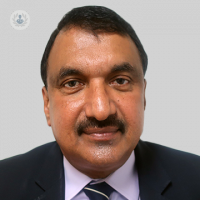Peripheral vascular disease: types, risk factors and treatment options
Written by:Peripheral vascular disease (PVD) is a condition that causes symptoms of pain on walking after a certain distance (known as claudication) and is due to the narrowing of the arteries that supply blood to the legs.
In the most severe cases, patients can have continuous pain even when at rest (known as 'rest pain') and it can also progress to ulcers or gangrene. If untreated, the patient has the risk of losing part or all of their leg.
We’ve asked top general and vascular surgeon Mr Sabu Jacob about the disease and its treatment options. Whether it’s from lifestyle modifications, angioplasty or vascular bypass surgery, the doctor will make the choice of procedure depending on the individual case and severity.

What are the different types of peripheral vascular disease?
Peripheral vascular disease can present as any of the following types:
- Claudication – which occurs as pain in the calf, thigh muscle and/or buttock muscle and is experienced after walking.
- Rest pain –is the severe pain experienced by patients even at rest and in bed.
- Tissue loss – that is the development of ulcers or gangrene.
What are the risk factors of PVD?
The disease tends to affect those who are middle-aged and smoking is a major risk factor. The other risk factors include diabetes, high blood pressure, family history and high cholesterol.
These can be managed if the patient stops smoking, engages in exercise, and takes control of their diabetes, high blood pressure and cholesterol levels by regularly having them monitored. Regular exercise can open up smaller vessels and can naturally bypass the blocked arteries.
How does vascular bypass treat peripheral vascular disease?
PVD can be treated with regular exercise, angioplasty or bypass surgery. Mild to moderate cases respond well to regular exercise programs and treating the risk factors. Most severe cases are treated by angioplasty and bypass. Bypass surgery is a major vascular procedure that uses the patient’s own vein or synthetic material to bypass the blocked artery.
How long does the surgery take?
Surgery depends on the extent of the disease and that can vary between three to five hours.
How long does the recovery period take?
Recovery will be between two to four weeks.
Is surgery the most effective treatment in the long term?
Angioplasty and stent are most effective for diseases above the groin. Angioplasty is also effective for narrowing of arteries and short blockages below the groin. However, for long blockages and following the failure of angioplasty, bypass surgery provides the best long-term results.
Once you have PVD you are likely to have more disease as it can affect other arteries in the body and is a continuous process.
What are the complications if left undiagnosed?
The complications are a progression of the disease to severe symptoms, such as rest pain and loss of tissues, both of which are high risk of limb loss (amputation).
Do not hesitate to book an appointment with Mr Sabu via his Top Doctor's profile here if you are concerned about your health and would like to discuss any of the above.


